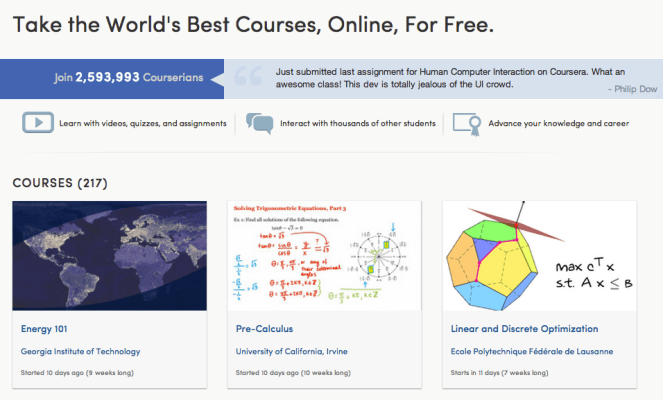Last year, the buzz around the potential of online courses (particularly MOOC platforms) reached new heights, and this year is already shaping up to be the one in which online course platforms and the startups that love them, make their big push for legitimacy. To wit: The year kicked off with the news that the largest university system in the world has partnered with Udacity to pilot low-cost, lower-division and remedial classes — online and, importantly, for credit — within the California State University system.
There is a growing list of institutions and startups that are on a mission to democratize education with affordable and scalable online course platforms, but the most familiar name in the world of MOOCs would have to be Coursera. Launched in 2011, Coursera has partnered with dozens of the country’s top universities to offer high-quality, Ivy League-caliber classes (on over 200 subjects) to anyone and everyone for free. For the sake of full disclosure, Coursera recently took home the “Best New Startup” award at The Crunchies.
In spite of a mission that nearly everyone can get behind, Coursera (and its ilk) haven’t been without their detractors. One of the biggest knocks against the startup in the early-going has been that it lacks an identifiable business model. Recently, Coursera has taken steps to fix that, moving towards revenue-generation with the launch of Career Services (an opt-in recruiting program that matches students with employers) and “Verified Certificates,” which allows students to verify the work they do on the platform — for a fee. It also marked the startup’s first foray into credentialing, which brings us to the second big knock against Coursera.
Up until now, the startup has not offered degrees or credits for its online classes, which has meant that Coursera classes have existed mostly as a way to pursue supplementary or continuing education — not as part of degree programs. But that changed today, as Coursera announced this morning that five of its courses have been approved for “credit equivalency” by the American Council on Education (ACE). This means that students who complete these five courses can receive college transfer credit at institutions that accept ACE recommendations.
So, importantly, Coursera’s new credit equivalency doesn’t automatically mean that every university it has partnered with automatically guarantees credit for the approved courses; instead, institutions have the option to accept or decline credit. In other words, it’s up to them.
The five courses include four undergrad courses and one vocational course, including Pre-Calculus from the University of California, Irvine; Introduction to Genetics and Evolution from Duke University; Bioelectricity: A Quantitative Approach from Duke University; and Calculus: Single Variable from the University of Pennsylvania and the vocational option, Intermediate Algebra from the University of California, Irvine.
Why is this important? Well, I’m glad you asked. For starters, Coursera’s accreditation victory represents another step forward in the evolution of online education. Platforms like StraighterLine have long offered online distance learning courses for college credit (ACE approved, by the way), but Coursera is the first among the fast-growing congregation of MOOC platforms to receive accreditation. Though it’s worth noting that Udacity is currently in the process of seeking approval as part of its partnership with California’s state universities.
This also opens the door for further evaluation of Coursera’s roster of courses, as the company plans to continue working with ACE to review and potentially approve more courses in the coming months. But, perhaps more importantly, offering courses for credit means that Coursera is moving closer to offering a real educational service. In other words, MOOCs have really been useful as supplemental learning tools, providing students or working professionals with the opportunity to brush up on subjects they’re familiar with or learn new skills to buffer their CVs.
But, with credit, Coursera is positioning its platform as one that can help students earn a degree — and not only that, but because it offers content exclusively from the nation’s top schools, that means students could one day earn an online degree from an Ivy League university. Or, at the very least, supplement their degree from State University X with credits from Princeton, Yale and the like.
Being able to take lower-level courses from elite institutions at a low cost has huge implications for students and, perhaps even on national graduation rates. As I said recently, “imagine being able to take a class at Princeton, get credit for it and not have to pay thousands to get it.” Let that soak in, and tell me that doesn’t have the potential to transform education, which is currently seeing record lows in acceptance rates at Ivy League schools and skyrocketing (trillion-dollar) student debt.
Online education offers students the opportunity to learn at their own pace, using multimedia tools, video and study resources that classrooms just can’t offer. This has huge appeal to move the needle on learning outcomes for the many intelligent students out there who fall behind because they don’t get an opportunity to practice core concepts and instead just go with the flow — the pace of which tends to be dictated by the faster learners.
What’s more, for those who have been skeptical that MOOC platforms like Coursera would be able to turn their free education model into viable, sustainable businesses, its new accreditation represents another big step in that direction. Coursera now has three revenue streams in Career Services, Verified Certificates and courses for credit. However, the former appears to be supplemental, while credited courses — tied into Certificates — will likely become the Golden Goose that brings Coursera to Monetization Island.
In order for students to receive certificates or credits, the platform requires students to sign up for its “Signature Track,” which provides verification for the work students do in their courses. Signature Tracks will be offered for the majority of its courses and students have up to three weeks from the beginning of the course to sign up, at which point they’re asked to take two photos with their webcam, one of themselves and the other of a photo ID.
This allows Coursera to create a “biometric profile of their unique typing patterns” by requiring them to type a short phrase. When they go to submit work for a course, they type the short phrase, which is then matched to their student ID. And while there is a fee for Signature Track, it pales in comparison to what these courses typically cost both in the classroom and online. Signature Tracks cost between $60 and $90 and proctored exams have a price tag of between $30 and $99. All in all, two or three college credits per course will cost between $90 and $190, Coursera says.
And while we’ve mentioned the apparent value in being able to take Princeton courses for credit, ACE approval also means that Coursera’s classes could be eligible for credit at 2,000 colleges and universities across the U.S. — for under $200.
While it’s hard to understate the potential significance of the startup’s ACE accreditation, it hasn’t been all sunshine, moonbeams and periwinkles for Coursera. The platform recently suffered its first big disaster — an ironic one, to boot — when one of its courses crashed just one week in and has subsequently been suspended. And what was that course, you ask? Why it was the “Fundamentals of Online Education: Planning and Application,” of course. Oh, the bittersweet irony.
In reaction, Coursera co-founder Andrew Ng told Forbes, “when someone first invented the book, someone had to invent the table of contents, the page numbers, the section headings … and we’re in the process of inventing those right now, and there will be missteps along the way.” Looks like it’s about time for Coursera to make its first investment in some CRM software, after all, Ng is right. While online education has been around for years, MOOCs are still in their infancy. Yes, it still seems hard to justify poor service with a “hey, we’re innovating here” excuse, but these are first-mover growing pains.
As Inside Higher Ed pointed out, students of the class reported that, as the professor scrambled to salvage the course, she did so “without an adequate technology infrastructure” to rely on. What’s more, the course “promised to teach students how to deal with these issues in their own online offerings,” as the description itself promised that students would learn how to design online courses, manage online classes and use web tools and Learning Management Systems. Again, the irony is so thick you could cut it with a knife.
Because MOOCs are, by definition, online courses offered at scale (potentially to huge groups of students), as How People Learn Online explains, the failure of Coursera’s course shows that when things go wrong on a MOOC platform, they affect a bigger audience than schools and educators are used to dealing with in their classrooms. These failures happen in front of the masses — online — where traditionally there has tended to be less empathy and tolerance of hang-ups than one finds in in-person contexts.
As word spreads about the growing number of affordable, quality courses (for credit) online — and the increasing ease of access — it’s easy to believe that millions of students could begin flocking to platforms like Coursera. While activity overload is a problem Coursera would love to have, solving these infrastructure and support issues now is critical — especially as MOOCs increasingly find themselves in the spotlight.
And you know what else is critical? Better authentication mechanisms and methods to ensure accuracy and prevent cheating. The potential for cheating in MOOCs is high, and some believe that Coursera’s keyboard dynamics (or stylometrics) are far from being a truly credible form of authentication. As students flock to online education platforms, this issue will become increasingly important.



